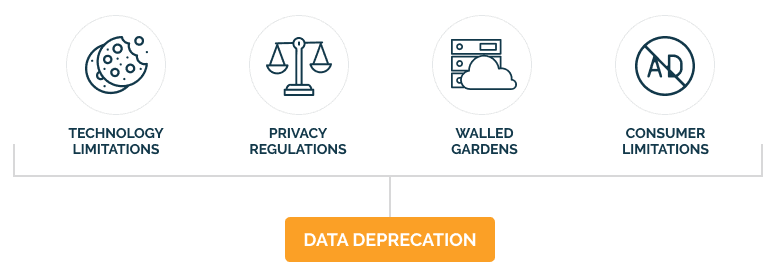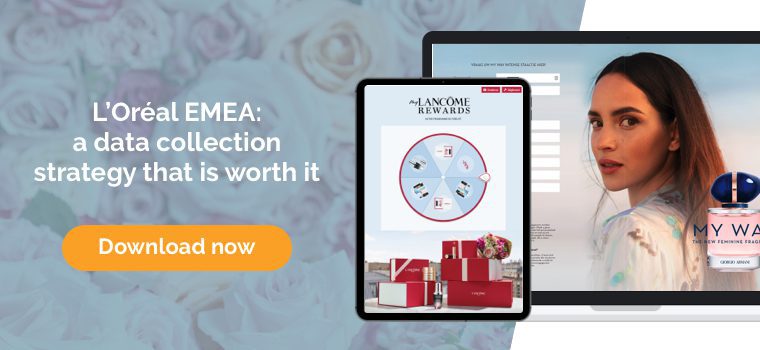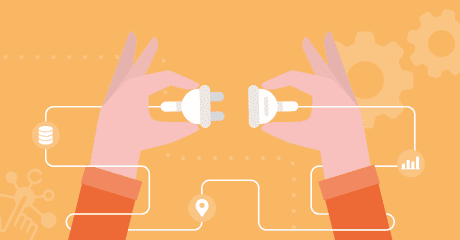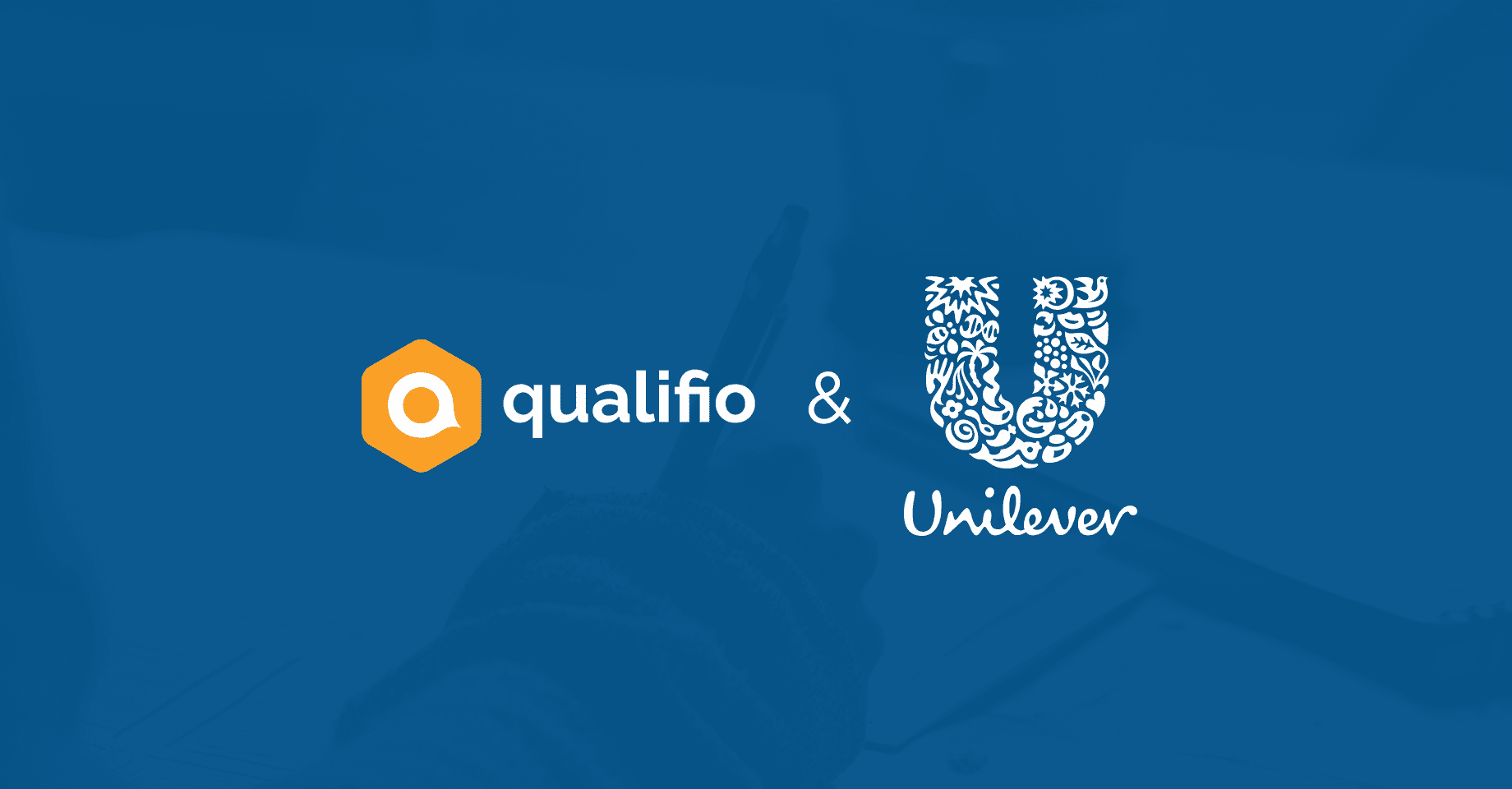Data deprecation: a step-by-step guide
What is data deprecation? And why does it matter so much?
Data deprecation refers to the process of intentionally and systematically discontinuing the use, storage, or availability of certain data. This can occur for various reasons, such as data becoming outdated, irrelevant, or potentially privacy-sensitive.
Data deprecation involves removing or limiting access to the deprecated data, often in compliance with privacy regulations or to improve data management practices. It helps organisations ensure that only current, accurate, and necessary data is maintained, while minimizing the risks associated with retaining unnecessary or sensitive information.
First-party data and zero-party data – you’ve been hearing more and more about these guys recently. Why? One simple reason: data deprecation.
“Data what?”
Data deprecation is one of the most talked about topics in recent years in the digital marketing ecosphere. But what is it? And why is it having an impact on how brands and consumers interact, share data and build relationships?
Let’s take a look!
Deprecated or depreciated?
Isn’t it amazing how one little letter can cause so much confusion!
Whenever the topic is broached, the most common response after ‘never heard of it, what’s data deprecation?’, is ‘are you sure you don’t mean depreciation’? And yes, we’re sure we mean deprecation and not depreciation!
Here’s why:
- When something is depreciated, it means that it has lost value. Think of it as the opposite of appreciated (to gain value).People generally use this term in a financial or economical context.
- On the other hand, in a technological context, deprecation mainly involves “expressing disapproval of something,” referring to belittling or frowning upon that thing.

Definition and the four forces
When something is deprecated, it means that although it is available or allowed, it is not recommended or that, in the case where it must be used, to say it is deprecated means that its failings are recognised.
And this is precisely what’s happening to consumer data: for years, brands have had an unbridled access to it so it is available and allowed, but it is no longer recommended for use. That is, of course, unless individuals consent to, comply with, transparently provide, and take action on the data.

There are 4 forces that are in play currently in the digital landscape, making it difficult for brands to collect and harness consumer data:
🖥 Technology limitations
Internet browsers are imposing data-sharing limitations to boost privacy protection. The end of third-party cookies provides a perfect example of this. Google announced it a few years ago, and another instance is Apple’s strict privacy policy.
Brands have relied on this type of data for years for targeting and segmenting purposes, but it will soon no longer be available.
⛔️ Privacy regulations
Privacy regulations like GDPR in Europe or the CCPA in California have emerged in numerous locations over the past few years, and they are becoming stricter and more punitive, resulting in the imposition of substantial fines.
🎍 Walled gardens
The big technology actors, such as Apple, Amazon, Google, and Facebook, are increasingly utilising walled gardens. This type of technology means that the service provider has control over all applications, content and media, and restricts convenient access to unapproved applicants and control.
🙅🏼♀️ Consumer limitations
Consumer awareness about data privacy means that they’re taking data-sharing limiting actions, such as ad-blockers. This is because consumers are becoming more aware of how companies are using and collecting their data. Today, an estimated 42.7% of internet users have activated an ad-blocker in their browser. And in recent years this technology has expanded beyond the desktop, to mobile devices and tablets. The main reasons given for using this technology are the amount of ads that consumers are exposed to, the irrelevance of the messages, and the intrusion factor.
What can be done to counter data deprecation?
It all sounds a bit daunting and foreboding doesn’t it? Brands have until recently pretty much had free access to consumer data, using it with a wide-ranging amount of caution and respect. But today that’s no longer the case. Consumers have understood the value of their personal data, and are therefore intent on protecting it.
So where to next? What can brands do to build their relationship with their audience on compliant, more respectful grounds?
Here are 4 actions that you can take to face data deprecation serenely:
♻️ Assess your current data collection strategy:
What types of data are you collecting? Are you using all the data that you’ve collected? Is your data all in one place and nicely organised? Or does it exist scattered across silos and remain incomplete? What integrations with solution providers do you have with your marketing tech stack? These are just a few questions you need to be asking yourself about your organisation.

Take a look at how Qualifio can integrate with your existing marketing tools.
✅ Take a look at the compliance of your data:
Are you asking your audience for their permission to collect and use their data? Do they know how you’re storing and using it? Remember that third-party data will soon be a thing of the past and unusable, so make sure that your strategy takes this into account and is a privacy-first strategy.
🙋🏼♀️ Collect first-party and zero-party data:
First-party data and zero-party data are the key in this whole data deprecation conundrum. By collecting these types of data, brands ensure that they possess consented and actionable data. The consumer has chosen to share their data with the brand and they’re doing so with the objective of having an improved brand experience. They no longer want irrelevant messages to bombard them; instead, they desire targeted and personalized communication from the brands they trust and love. For communication retention, consider the benefits of a virtual call center.
🧚🏼 Try out new ways of collecting data:
With interactive marketing, gamification and interaction-based loyalty programs for example. They’re perfect for getting a better understanding of your audience, so that you know their needs and expectations. This will then allow you to offer them personalised experiences, to reward them for their interactions with your brand, and provide them with content that is relevant to them.
Why L’Oréal’s data collection strategy is worth it
Having a global data collection strategy is essential for brands, especially as we’ve seen in the context of data deprecation. And L’Oréal EMEA is the perfect example of how a well-thought and structured strategy can have wide ranging benefits.
Initially all of the brands within the group were using different tools and agencies to collect data, so the workflow was complicated and chaotic, with many data silos. That’s why they launched a European data capture program with Qualifio Engage that was directly integrated with their CRM. They wanted all their brands to be able to recruit new customers and enrich the data of their existing customers.
L’Oréal had 2 objectives:
1️⃣ Increase the number of contacts in their database
2️⃣ Improve the quality of these contacts
And in just over a year, companies launched over 700 campaigns, involving 5.5 million users and resulting in the creation of 60-70% of accounts per campaign.

Curious to find out more about how L’Oréal implemented an efficient and successful data collection strategy?
How Qualifio can help
Brands need to take data deprecation seriously as they can no longer rely on consumer data that they haven’t acquired in a compliant and transparent manner. Moving forward, to keep in touch and to keep building relationships with their audience, they’re going to need to collect data from them that is actionable and consented. First- and zero-party data are the perfect solution for this, and one of the best ways of collecting it is with interactive marketing.
Qualifio is the leading European first- and zero-party data collection platform for consumer brands. We enable marketing teams to get to know their audiences thanks to two complementary SaaS modules:
- Qualifio Engage allows them to generate engagement and capture data via quizzes, games, polls, contests, and over 50 other interactive formats.
- Qualifio Loyalty empowers them to reward and segment members with interaction-based programs that go beyond purchases.
Are you interested in having a demo of our interactive marketing and data collection module? Request your free and personalised demo now!










